For years Ian has told me about doors in the Mersey River when we passed Martha Creek. It was intriguing but I couldn’t really imagine what they might be. In February, they came up again when we were talking about places to explore. We would wrap in a few easy searches into one day; Ian’s Mersey Doors, a marker tree from the 1890–91 Mole Creek to Zeehan railway survey and a hut at an old copper prospect. It would be an easy day.
We stopped at Martha Creek and walked down to the Mersey River. The 2016 floods had carved and reshaped the landscape. Big shingle banks had been formed. Uprooted trees and scrub formed walls of debris and the banks had been scoured clean in places. It was still a pretty walk and as we walked Ian recalled details about these doors.
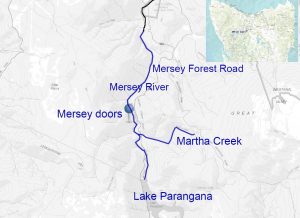
About 40 years ago, he and his friends had walked down the Mersey just to see what it was like. Somewhere not far downstream from the Parangana Dam the river bent to the west deflected by high rocky cliffs. On the western bank, just past the bend the doors were dug into a spur. Ian recalled that they were only a little above river level and made of weathered timber. They were also locked to exclude and protect the overly curious. Ian remembered a wire rope strung high across the river. At the time, he thought that he and his friends had found a mine and the rope was a flying fox used to access it.
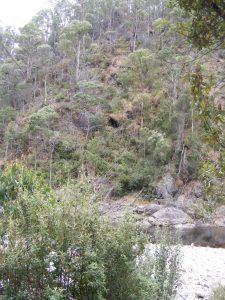
We walked downstream, clambered over a wall of dead trees and waded across the river to the western side. A little further downstream, Ian started to get excited. The river turned west around a spur facing cliffs. It felt right. Around the corner, Ian saw a wire rope draped between the banks of the river. Now our pulses started to race. This must be the general area.
Ian stood for a few moments reflecting, looked at the bank and then pointed. It should be there. On the river bank, just above water level, now covered in fallen timber and scrub. It has also been heavily scoured by flood waters. Ian ferreted in amongst the dead heaps of timber. There was nothing obvious. We were stumped for the moment. We turned to the one piece of evidence we had, the wire rope.
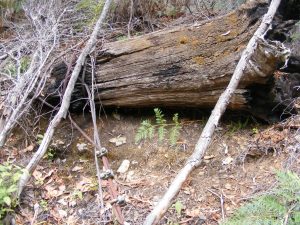
We clambered up the bank onto the wooded spur. The wire rope led to a coil of rope and fittings wrapped around an uprooted stump. The more we looked the more obvious it was that the spur had been cleared. There were signs of tracks, stumps further up the spur and some levelled earth where the flying fox would have been loaded and unloaded.
We looked around a little more. There were clues but no doors. They may have been washed out in the 2016 floods. We gave up the search here and went further downstream to look for the copper hut.
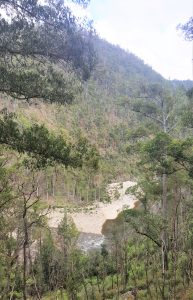
Later we walked back along Mersey Forest Road. We looked down towards where the doors should have been and pondered where the wire rope went below us on the eastern bank. I invited Ian to go down the slope to look. I’d wait, it was way too steep for me. Without more information Ian’s Mersey doors would be just a memory.
We had picked up a clue. The activity was comparatively modern. That led to a quick trip to Archives in Hobart. We then had enough information to return for another look for the Mersey doors.
Back again
We came in the same way, waded the river again and reached the wire. This time we went down a little further downstream. In some thick scrub on the bank was a long narrow stack of rock and dirt. A ‘finger dump’ where the diggings from a tunnel were heaped. We followed it deeper into the thick low vegetation. A piece of corrugated iron stuck out of some soil and then …. nothing. Just dirt. We knew we were in the right spot. But we would never find the doors.
Further up the bank was the crescent scar of bare earth left by a landslip. It was only a few years old. The doors were buried. But all was not lost. Our research had shown a second tunnel on the other side of the river.
Part way up the steep bank was a dark gaping hole. That’s where we headed. Again, we waded the river. Then we started up. It wasn’t all cliff but it wasn’t far from it. The bank got steeper. I started kicking steps into what little soil there was. Slowly we worked our way up. Picking the best line, finding the best steps and grabbing any semi-secure rock or vegetation. My heart was in my mouth, it was long drop to the river.
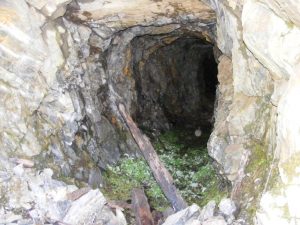
We reached the hole. It was a tunnel. The entry partly blocked by fallen rock and a few burnt collapsed beams. The rest was solid rock. There were drill holes in the rock and detonator wire. The tunnel stopped after about 10 metres.
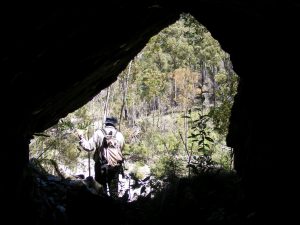
Now to get back to the car. Going down was too dangerous. We climbed up towards Mersey Forest Road. On the way to the top we glimpsed the rusty cage that once crossed on the wire marooned in some scrub. Then we reached where the wire had been secured on this bank. It seemed an eternity before we reached the safety of the road. The view down seemed worse than I remembered it from the few days before. I wasn’t going back there. At last, I could relax and chat with Ian about what we had seen.
The doors explained
The wire told us that the work was fairly modern. The location is just below Lake Parangana. Our guess was that it was work done by the Hydro-Electric Commission. Archives confirmed the Mersey River near Martha Creek was investigated to be a dam site in the Mersey-Forth Power Scheme in the 1960s.

The plan shows the proposed location of the dam wall, adits (tunnels) in the banks and a series of boreholes. A more detailed plan showed the layout of the tunnels.
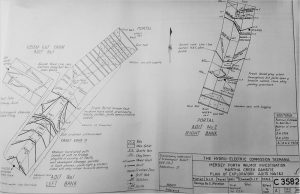
We had seen the inside of the eastern tunnel. We had to rely on the plans to reveal the western tunnel. The entrance was supported by a lot of timber, indicating that it must have been unstable. By the time we reached the site, the timbers had lost their fight with gravity. If Ian had been able to see inside 40 years ago he would have found a cross cut as well.
This little adventure didn’t result in a long forgotten mine. But it did answer the questions; what were the doors in the Mersey and what was behind them. It shows that sometimes it takes a long time to get around to scratching some old itch but it is never too late.
Peter Brown 2021
I don’t suppose any of us know what’s really in our back yard do we.
I knew about these adits for years and have always wanted to go and find them as well, they are still technically a Hydro Tasmania assett but we (Hydro) have no need to go there any more. I know the two drillers that worked there back in the day, they both have many fond memories of working in these remote locations before the dams where built.
Thanks Stewart. Those drillers had some great places to work. Ian passes on his regards to Brian.